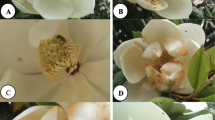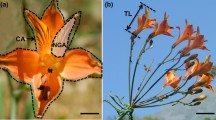Abstract
Plant reproduction can be strongly affected by herbivory and different features of pollination ecology, such as pollinator visitation rates and capacity for self-pollination. The purpose of this study is to compare the relative impact of herbivory and pollination on maternal reproductive success in endemic Aquilegia viscosa and its widespread congener Aquilegia vulgaris. We conducted herbivore exclusion experiments in two populations of each species in 2 different years and showed that the maternal fertility of A. viscosa was significantly more limited by floral predation and pre-dispersal seed predation than its widespread congener. In the absence of herbivory, A. viscosa retained significantly lower maternal fertility than A. vulgaris. Experimental pollinations in an insect-free glasshouse showed that the two species have an equal seed/ovule ratio both in the absence of pollinators and in the presence of non-limiting outcross pollination. Pollinator visitation rates were significantly higher in populations of A. vulgaris than in populations of A. viscosa. In addition, path analyses showed that spur length, an important trait for pollinator attraction in Aquilegia, and, indirectly sepal and petal width, contribute positively to the seed/ovule ratio in A. vulgaris, but not in A. viscosa. These results indicate that maternal fertility of endemic A. viscosa is strongly reduced by flower and seed predation despite low rates of pollinator visitation, and that pollen or resource limitation in the wild may further reduce maternal fertility. Finally, floral trait variation appears to be decoupled from fertility variation in endemic A. viscosa, which possibly constrains the evolution of reproductive traits in this species.




Similar content being viewed by others
References
Ågren J (1996) Population size, pollinator limitation, and seed set in the self-incompatible herb Lythrum salicaria. Ecology 77:1779–1790
Affre L, Thompson JD, Debussche M (1995) The reproductive biology of the Mediterranean endemic Cyclamen balearicum. Bot J Linn Soc 118:309–330
Ayre DJ, Whelan RJ (1989) Factors controlling fruit set in hermaphrotidic plants: studies with Australian Proteaceae. Trends Ecol Evol 4:267–272
Baker AM, Barrett SCH, Thompson JD (2000) Variation of pollen limitation in the early-flowering Mediterranean geophyte Narcissus assoanus (Amaryllidaceae). Oecologia 124:529–535
Bevill RL, Louda SM, Stanforth LM (1999) Protection from natural enemies in managing rare plant species. Conserv Biol 13:1323–1331
Brunet J, Eckert CG (1998) Effects of floral morphology and display on outcrossing in Blue Colombine, Aquilegia caerulea (Ranunculaceae). Funct Ecol 12:596–606
Burd M (1994) Bateman’s principle and plant reproduction: the role of pollen limitation in fruit and seed set. Bot Rev 60:83–139
Byers DL, Meagher TR (1997) A comparison of demographic characteristics in a rare and a common species of Eupatorium. Ecol Appl 7:519–530
Charpentier A, Grillas P, Thompson JD (2000) The effects of population size limitation on fecundity in mosaic populations of the clonal macrophyte Scirpus martitimus. Am J Bot 87:502–507
Chauvet M (1989) Plantes sauvages menacées de France: bilan et protection. Actes du colloque de Brest. Lavoisier, Cachan, 8–10 October 1987
Cowling RM, Witkowski ETF, Milewski AV, Newbey KR (1994) Taxonomic, edaphic and biological aspects of narrow endemism on matched sites in mediterranean South Africa and Australia. J Biogeogr 21:651–664
Desmet PG, Cowling RM (1999) Biodiversity, habitat and range size of a flora from a winter-rainfall desert in north-western Namaqualand, South Africa. Plant Ecol 142:23–33
Eckert CG, Schaefer A (1998) Does self-pollination provide reproductive assurance in Aquilegia canadensis (Ranunculaceae)? Am J Bot 85:919–924
Ehrlèn J (1996) Spatiotemporal variation in predispersal seed predation intensity. Oecologia 108:708–713
Eriksson O, Jakobsson A (1998) Abundance, distribution and life-histories of grassland plants: a comparative study of 81 species. J Ecol 86:922–933
Escarré J, Lepart J, Sans X, Sentuc JJ, Gorse V (1999) Effects of herbivory on the growth and reproduction of Picris hieracioides in the Mediterranean region. J Veg Sci 10:101–110
Fletcher JD, Shipley LA, McShea WJ, Shumway DL (2001) Wildlife herbivory and rare plants: the effects of white-tailed deer, rodents, and insects on growth and survival of Turk’s cap lily. Biol Conserv 101:229–238
Gaston KJ, Kunin WE (1997) Rare-common differences: an overview. In: Kunin WE, Gaston KJ (eds) The biology of rarity: causes and consequences of rare-common differences. Chapman and Hall, London, pp 12–29
Hedge SG, Ellstrand NC (1999) Life history differences between rare and common flowering plant species of California and the British Isles. Int J Plant Sci 160:1083–1091
Herrera CM (2000) Measuring the effects of pollinators and herbivores: evidence for non-additivity in a perennial herb. Ecology 81:2170–2176
Herrera CM, Sanchez-Lafuente A, Medrano M, Guitian J, Cerda X, Rey P (2001) Geographical variation in autonomous self-pollination levels unrelated to pollinator service in Helleborus foetidus (Ranunculaceae). Am J Bot 88:1025–1032
Herrera CM, Medrano M, Rey PJ, Sánchez-Lafuente AM, García MB, Guitián J, Manzaneda AJ (2002) Interaction of pollinators and herbivores on plant fitness suggests a pathway for correlated evolution of mutualism- and antagonism-related traits. Proc Natl Acad Sci USA 99:16823–16828
Hodges SA, Arnold ML (1994) Columbines: a geographically widespread species flock. Proc Natl Acad Sci USA 91:25129–25132
Karron JD (1997) Genetic consequences of different patterns of distribution and abundance. In: Kunin WE, Gaston KJ (eds) The biology of rarity: causes and consequences of rare-common differences. Chapman and Hall, London, pp 174–189
Kéry M, Matthies D, Spillmann H (2000) Reduced fecundity and offspring performance in small populations of the declining grassland plants Primula veris and Gentiana lutea. J Ecol 88:17–30
Kéry M, Matthies D, Fischer M (2001) The effect of plant population size on the interactions between the rare Gentiana cruciata and its specialized herbivore Maculinea rebeli. J Ecol 89:418–427
Kunin WE (1997) Population biology and rarity: on the complexity of density dependence in insect–plant interactions. In: Kunin WE, Gaston KJ (eds) The biology of rarity: causes and consequences of rare-common differences. Chapman and Hall, London, pp 150–173
Landa K, Rabinowitz D (1983) Relative preference of Arphia sulphurea (Orthoptera:Acridiae) for sparse and common prairie grasses. Ecology 64:392–395
Lavergne S, Garnier E, Debussche M (2003) Do rock endemic and widespread plant species differ under the Leaf-Height-Seed plant ecology strategy scheme? Ecol Lett 6:398–404
Lavergne S, Thompson JD, Garnier E, Debussche M (2004) The biology and ecology of endemic and widespread plants: a comparative study of trait variation in 20 congeneric pairs. Oikos (in press)
Levri MA, Real LA (1998) The role of resources and pathogens in mediating the mating system of Kalmia latifolia. Ecology 79:1602–1609
Lord JM, Kelly D (1999) Seed production in Festuca novae-zelandiae: the effect of altitude and pre-dispersal predation. N Z J Bot 37:503–509
Louda SM (1982) Limitation of the recruitment of the shrub Haplopappus squarrosus (Asteraceae) by flower and seed feeding insects. J Ecol 70:42–53
Matsumura C, Whashitani I (2000) Effects of population size and pollinator limitation on seed set of Primula sieboldii populations in a fragmented landscape. Ecol Res 15:307–322
Médail F, Verlaque R (1997) Ecological characteristics and rarity of endemic plants from southeast France and Corsica: implications for biodiversity conservation. Biol Conserv 80:269–281
Murray BR, Thrall PH, Gill AM, Nicotra AB (2002) How plant life-history and ecological traits relate to species rarity and commonness at varying spatial scales. Aust Ecol 27:291–310
Robertson AW, Kelly D, Ladley JJ, Sparrow AD (1998) Effects of pollinator loss on endemic New Zealand Mistletoes (Loranthaceae). Conserv Biol 13:499–508
Saez L, Rossello JA, Vigo J (1998) Catàleg de les plantes vasculars endèmiques, rares o amenaçades de Catalunya. I. Tàxons endèmics. Acta Bot Barcinonensia 45:309–321
SAS (1999) SAS/STAT user’s guide. SAS Institute, Cary, N.C.
Scheidel U, Bruelheide H (1999) Selective slug grazing on montane meadow plants. J Ecol 87:828–838
Sih A, Baltus M-S (1987) Patch size, pollinator behavior, and pollinator limitation in Catnip. Ecology 68:1679–1690
Silvertown J, Franco M, Pisanty I, Mendoza A (1993) Comparative plant demography—relative importance of life-cycle components to the finite rate of increase in woody and herbaceous perennials. J Ecol 81:465–476
Simon J, Bosch M, Molero J, Blanché C (2001) Conservation biology of the Pyrenean larkspur (Delphinium montanum): a case conflict of plant versus animal conservation? Biol Conserv 98:305–314
Solbrig OT, Rollins RC (1977) The evolution of autogamy in species of the mustard genus Leavenworthia. Evolution 31:265–281
Strauss SY, Armbruster WS (1997) Linking herbivory and pollination: new perspectives on plant and animal ecology and evolution. Ecology 78:1617–1618
Strauss SY, Conner JK, Rush SL (1996) Foliar herbivory affects floral characters and plant attractiveness to pollinators: implications for male and female fitness. Am Nat 147:1098–1107
Thompson JD (2001) How do visitation patterns vary among pollinators in relation to floral display and floral design in a generalist pollination system? Oecologia 126:386–394
Thompson JD, Tarayre M, Gauthier P, Litrico I, Linhart YB (2004) Multiple genetic contributions to plant performance in Thymus vulgaris. J Ecol 92:45–56
Wyatt R (1986) Ecology and evolution of self-pollination in Arenaria uniflora (Caryophyllaceae). J Ecol 74:403–418
Acknowledgements
The authors thank Clélia Sirami, Claire Lagaye and Sophie Dubois for help with field work and Annabelle Dos Santos and Geneviève Debussche for technical help. The CNRS, the European Laboratory (LEA) “Mediterranean ecosystems in a changing world”, the Conservatoire Botanique National Méditerranéen de Porquerolles, l’Institut Français de la Biodiversité and the Région Languedoc-Roussillon provided financial support. The authors thank the Conservatoire-Etudes des Ecosystèmes de Provence and the Conservatoire des Espaces Naturels du Languedoc-Roussillon for logistic help and the Conservatoire Botanique National Méditerranéen for permission to sample plant material.
Author information
Authors and Affiliations
Corresponding author
Rights and permissions
About this article
Cite this article
Lavergne, S., Debussche, M. & Thompson, J.D. Limitations on reproductive success in endemic Aquilegia viscosa (Ranunculaceae) relative to its widespread congener Aquilegia vulgaris: the interplay of herbivory and pollination. Oecologia 142, 212–220 (2005). https://doi.org/10.1007/s00442-004-1721-1
Received:
Accepted:
Published:
Issue Date:
DOI: https://doi.org/10.1007/s00442-004-1721-1




